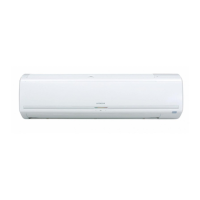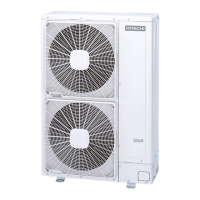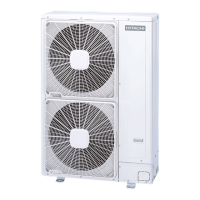Do you have a question about the Hitachi RAS-6HVRNM2 and is the answer not in the manual?
Definitions for DANGER, WARNING, CAUTION, and NOTICE signal words used in the manual.
Critical warnings related to installation, refrigerant, and electrical safety.
Safety advice on sprays, grounding, wiring, foundations, and installation locations.
Notes on installation near electromagnetic waves and potential power source issues.
Recommendations for room ventilation and auxiliary heating in low-temperature regions.
Lists and diagrams identifying the parts of the 3HP outdoor unit model.
Lists and diagrams identifying the parts of the 4-7HP outdoor unit models.
Lists all tools and instruments needed for the installation process.
Safety notes regarding R410A pressure, impurities, and handling.
Details interchangeability of tools for R410A, R22, and R407C refrigerants.
Step-by-step process for selecting the appropriate unit model based on load calculations.
Table detailing compatible combinations for various outdoor and indoor unit models.
Guidelines for advanced combinations and capacity matching between units.
Instructions for lifting and hanging the unit using ropes, with and without a wooden base.
Guidance on using unit handles, considering weight and safe movement.
Verifying included accessories such as anchor bolts before installation.
Crucial warnings for installation locations, conditions, and potential hazards.
Checks for ventilation, noise, foundation stability, and environmental hazards.
Guidance on installing optional wind guards and snow protection hoods.
Diagrams and dimensions for clearance around the unit for operation and maintenance.
Instructions for anchoring the unit firmly using bolts and fixing plates.
Guidelines for drain water management and stable foundation setup.
Critical warnings about using correct refrigerant and potential hazards.
Precautions for refrigerant leakage, suffocation, and fire risks.
Safety advice for brazing work and tightening flare nuts.
Selecting and preparing copper pipes, including end protection.
Steps for connecting pipes, applying oil, and tightening flare nuts correctly.
Specifications for flaring tubes and selecting joints for different pipe materials.
Guidelines for selecting pipe sizes based on unit capacity and piping configurations.
Details on piping length and selection for multi-branch systems.
Information on connecting pipes, posture, and pressure measurement.
Guidance on connecting pipes from different directions and accessing the service cover.
Details on connecting pipes from various directions and protecting cables.
Procedures for connecting piping, tightening stop valves, and checking torque.
Critical warnings to prevent shock or fire during wiring work.
Instructions for securing cables and tightening terminals with specified torque.
Verifying electrical components, power supply, wiring, and grounding.
Diagrams and instructions for connecting power and control cables to the outdoor unit.
Wiring configurations for single, twin, triple, and quad unit setups.
Tables specifying wire sizes for power and transmitting cables.
Instructions for setting dip switches for operation modes and system settings.
Configuration for transmitting, refrigerant cycle numbers, and terminal resistance.
Instructions for setting simultaneous or individual operation modes for multiple units.
Steps for performing an air-tight test using nitrogen gas and leak detection.
Instructions for vacuuming the system and charging refrigerant.
Method for calculating additional refrigerant based on piping length and unit capacity.
Guidelines on calculating and maintaining safe refrigerant concentration in rooms.
Verifying power, voltage, insulation, stop valves, and working ranges before operation.
Detailed steps for performing the test run using the wired remote control switch.
Configuring optional functions and external input/output settings.
Lists and explains various alarm codes and their potential causes.
Details on high pressure and low pressure cut-out/cut-in settings for the compressor.
Information on fan motor speed reduction based on temperature.
Definitions for DANGER, WARNING, CAUTION, and NOTICE signal words used in the manual.
Critical warnings related to installation, refrigerant, and electrical safety.
Safety advice on sprays, grounding, wiring, foundations, and installation locations.
Notes on installation near electromagnetic waves and potential power source issues.
Recommendations for room ventilation and auxiliary heating in low-temperature regions.
Lists and diagrams identifying the parts of the 3HP outdoor unit model.
Lists and diagrams identifying the parts of the 4-7HP outdoor unit models.
Lists all tools and instruments needed for the installation process.
Safety notes regarding R410A pressure, impurities, and handling.
Details interchangeability of tools for R410A, R22, and R407C refrigerants.
Step-by-step process for selecting the appropriate unit model based on load calculations.
Table detailing compatible combinations for various outdoor and indoor unit models.
Guidelines for advanced combinations and capacity matching between units.
Instructions for lifting and hanging the unit using ropes, with and without a wooden base.
Guidance on using unit handles, considering weight and safe movement.
Verifying included accessories such as anchor bolts before installation.
Crucial warnings for installation locations, conditions, and potential hazards.
Checks for ventilation, noise, foundation stability, and environmental hazards.
Guidance on installing optional wind guards and snow protection hoods.
Diagrams and dimensions for clearance around the unit for operation and maintenance.
Instructions for anchoring the unit firmly using bolts and fixing plates.
Guidelines for drain water management and stable foundation setup.
Critical warnings about using correct refrigerant and potential hazards.
Precautions for refrigerant leakage, suffocation, and fire risks.
Safety advice for brazing work and tightening flare nuts.
Selecting and preparing copper pipes, including end protection.
Steps for connecting pipes, applying oil, and tightening flare nuts correctly.
Specifications for flaring tubes and selecting joints for different pipe materials.
Guidelines for selecting pipe sizes based on unit capacity and piping configurations.
Details on piping length and selection for multi-branch systems.
Information on connecting pipes, posture, and pressure measurement.
Guidance on connecting pipes from different directions and accessing the service cover.
Details on connecting pipes from various directions and protecting cables.
Procedures for connecting piping, tightening stop valves, and checking torque.
Critical warnings to prevent shock or fire during wiring work.
Instructions for securing cables and tightening terminals with specified torque.
Verifying electrical components, power supply, wiring, and grounding.
Diagrams and instructions for connecting power and control cables to the outdoor unit.
Wiring configurations for single, twin, triple, and quad unit setups.
Tables specifying wire sizes for power and transmitting cables.
Instructions for setting dip switches for operation modes and system settings.
Configuration for transmitting, refrigerant cycle numbers, and terminal resistance.
Instructions for setting simultaneous or individual operation modes for multiple units.
Steps for performing an air-tight test using nitrogen gas and leak detection.
Instructions for vacuuming the system and charging refrigerant.
Method for calculating additional refrigerant based on piping length and unit capacity.
Guidelines on calculating and maintaining safe refrigerant concentration in rooms.
Verifying power, voltage, insulation, stop valves, and working ranges before operation.
Detailed steps for performing the test run using the wired remote control switch.
Configuring optional functions and external input/output settings.
Lists and explains various alarm codes and their potential causes.
Details on high pressure and low pressure cut-out/cut-in settings for the compressor.
Information on fan motor speed reduction based on temperature.
| Brand | Hitachi |
|---|---|
| Model | RAS-6HVRNM2 |
| Category | Air Conditioner |
| Language | English |












